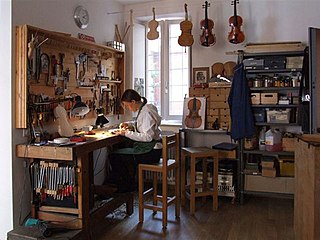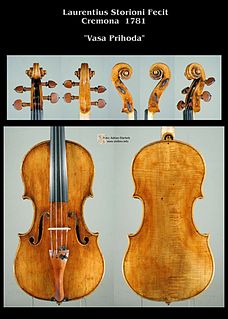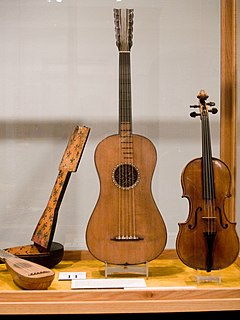Related Research Articles

The cello ( CHEL-oh; plural celli or cellos) or violoncello ( VY-ə-lən-CHEL-oh; Italian pronunciation: [vjolonˈtʃɛllo]) is a bowed (and occasionally plucked) string instrument of the violin family. Its four strings are usually tuned in perfect fifths: from low to high, C2, G2, D3 and A3. Each string is an octave lower than the viola's four strings. Music for the cello is generally written in the bass clef, with tenor clef and treble clef used for higher-range passages.

The guitar is a fretted musical instrument that usually has six strings. It is typically played with both hands by strumming or plucking the strings with either a guitar pick or the fingers/fingernails of one hand, while simultaneously fretting with the fingers of the other hand. The sound of the vibrating strings is projected either acoustically, by means of the hollow chamber of the guitar, or through an electrical amplifier and a speaker.

The violin, sometimes known as a fiddle, is a wooden chordophone in the violin family. Most violins have a hollow wooden body. It is the smallest and thus highest-pitched instrument (soprano) in the family in regular use. The violin typically has four strings, usually tuned in perfect fifths with notes G3, D4, A4, E5, and is most commonly played by drawing a bow across its strings. It can also be played by plucking the strings with the fingers (pizzicato) and, in specialized cases, by striking the strings with the wooden side of the bow.

A Stradivarius is one of the violins, violas, cellos and other string instruments built by members of the Italian family Stradivari, particularly Antonio Stradivari, during the 17th and 18th centuries. According to their reputation, the quality of their sound has defied attempts to explain or equal it, though this belief is disputed. The fame of Stradivarius instruments is widespread, appearing in numerous works of fiction.
In music, a bow is a tensioned stick which has hair coated in rosin affixed to it. It is moved across some part of a musical instrument to cause vibration, which the instrument emits as sound. The vast majority of bows are used with string instruments, such as the violin, although some bows are used with musical saws and other bowed idiophones.

A luthier is a craftsperson who builds and repairs string instruments that have a neck and a sound box. The word "luthier" is originally French and comes from the French word for lute. The term was originally used for makers of lutes, but it came to be used already in French for makers of most bowed and plucked stringed instruments such as members of the violin family and guitars. Luthiers, however, do not make harps or pianos; these require different skills and construction methods because their strings are secured to a frame.

An archtop guitar is a hollow steel-stringed acoustic or semiacoustic guitar with a full body and a distinctive arched top, whose sound is particularly popular with jazz, blues, and rockabilly players.

A violin consists of a body or corpus, a neck, a finger board, a bridge, a soundpost, four strings, and various fittings. The fittings are the tuning pegs, tailpiece and tailgut, endpin, possibly one or more fine tuners on the tailpiece, and in the modern style of playing, usually a chinrest, either attached with the cup directly over the tailpiece or to the left of it. There are many variations of chinrests such as clamped to the body in the center, on either side of the tailpiece as with a Guaneri style chinrest or to the left of the tailpiece.

The violin, viola, and cello were first made in the early 16th century, in Italy. The earliest evidence for their existence is in paintings by Gaudenzio Ferrari from the 1530s, though Ferrari's instruments had only three strings. The Academie musicale, a treatise written in 1556 by Philibert Jambe de Fer, gives a clear description of the violin family much as we know it today.
A solid-body musical instrument is a string instrument such as a guitar, bass or violin built without its normal sound box and relying on an electromagnetic pickup system to directly detect the vibrations of the strings; these instruments are usually plugged into an instrument amplifier and loudspeaker to be heard. Solid-body instruments are preferred in situations where acoustic feedback may otherwise be a problem and are inherently both less expensive to build and more rugged than acoustic electric instruments.

A flamenco guitar is a guitar similar to a classical guitar but with thinner tops and less internal bracing. It usually has nylon strings, as opposed to steel. Usually, it has a livelier sound compared to the classical guitar. It is used in toque, the guitar-playing part of the art of flamenco.
Tonewood refers to specific wood varieties that possess tonal properties that make them good choices for use in woodwind or acoustic stringed instruments.

Violin acoustics is an area of study within musical acoustics concerned with how the sound of a violin is created as the result of interactions between its many parts. These acoustic qualities are similar to those of other members of the violin family, such as the viola.

Carlo Bisiach (1892–1968) was a violin maker born in Milan Italy. Bisiach’s work contributed to the rebirth of violin making in the region after the difficult times of World War I and World War II. After working with his father Leandro in Milan and then Siena, Carlo established himself at Florence in 1922. The most talented of Leandro’s sons, Carlo went on to develop his own style quite separate from the Antoniazzi-derived work of his father and brothers.

Leandro Bisiach was an Italian violin maker, who was born in Casale Monferrato and died in 1945 at Venegono Superiore near Varese.

The Voller Brothers, William, Alfred and Charles, were craftsmen who worked in Streatham, London, from 1885 to 1927 and are best known for their imitations of fine violins and the imfamous "Balfour" Stradivarius.
Arthur Edward Smith, known as A. E. Smith, was an English-born Australian violin and viola maker whose violins and violas are prized for their 'excellence of tone' and 'decorative elements'. According to some musicians, "it is his violas that have the greatest reputation, being easily counted amongst the greatest ever created, regardless of era or nationality."

Lorenzo Storioni is considered one of the last of the classic Cremonese master violin makers/luthiers of the 18th century.
Tim Jansma was a notable contemporary luthier; a maker of violins, violas and cellos. He apprenticed at William Moennig and Son in Philadelphia and graduated from the International School of Violin Making of Cremona, Italy. The original Jansma Violin Shop was in Cremona, Italy and later was permanently established in Fremont, Michigan, USA in 1977. Jansma instruments are sold around the world to professional musicians and students.

The Rawlins Stradivarius is an antique guitar crafted by Antonio Stradivari in 1700. It is one of only four surviving guitars made by the Italian luthier. The Rawlins was purchased by the National Music Museum in South Dakota from violinist Louis Krasner in 1985. Krasner had purchased it in 1934 through a dealer in London.
References
- ↑ The Roadshow Archive, Gagliano Family Violin & François Nicolas Voirin Bow, ca. 1800: "... made of Yugoslavian maple. This is a very high grade of maple, very light and very strong, the best violin-making wood in the world.
- 1 2 Evans 2004, p. 179: "Antonio travels to Italy and Germany to select Yugoslavian spruce or the more beautiful maple, the woods with the finest resonance."
- ↑ Harvey 1995, p. 52: "The table wood of the classic Italian makers probably came from the Tyrol or what became northern Yugoslavia or Switzerland ..."
- ↑ Strings, Volume 10, p. 26: "From aged Yugoslavian maple come some of the finest back plates"
Sources
- Strings, Volume 10, String Letter Corporation, 1995
- David J. J. Evans (2004), Portugal , New Holland Publishers, ISBN 9781860111266
- Brian W. Harvey (1995), The violin family and its makers in the British Isles: an illustrated history and directory, Clarendon Press, ISBN 9780198162599